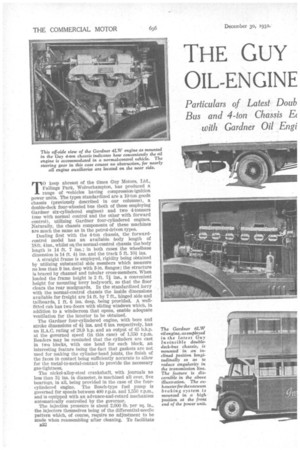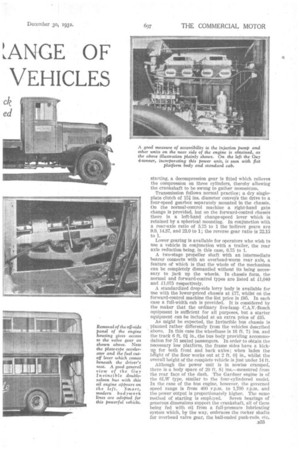THE GUY OIL-ENGINE LANGE OF VEHICLES
Page 46

Page 47

Page 48

If you've noticed an error in this article please click here to report it so we can fix it.
TO keep abreast of the times Guy Motors, Ltd., Fallings Park, Wolverhampton, has produced a range of ',vehicles having compression-ignition power units. The types standardized are a 10-ton goods chassis (previously described in our columns), a double-deck four-wheeled bus (both of these employing Gardner six-cylindered engines) and two 4-toimers (one with normal control and the other with forward control), utilizing Gardner four-cylindered engines. Naturally, the chassis components of these machines are much the same as in the petrol-driven types.
Dealing first with the 4-ton chassis, the forwardcontrol model has an available body length of 18 ft. 4 ins., whilst on the normal-control chassis the body length is 14 ft. 7 ins.; in both cases the wheelbase dimension is 14 ft. 41 ins, and the track 5 ft. 101 ins.
A straight frame is employed, rigidity being obtained by utilizing substantial side members which measure no less than 9 ins, deep with 3-in, flanges; the structure is braced by channel and tubular cross-members. When loaded the frame height is 2 ft. 7.1 ins., a convenient height for mounting lorry bodywork, so that the floor clears the rear mudguards. In the standardized lorry with the normal-control chassis the inside dimensions available for freight are 14 ft. by 7 ft., tinged side and tailboards, I ft. 6 ins. deep, being provided. A wellfitted cab has two doors with sliding windows which, in addition to a windscreen that opens, enable adequate ventilation for the interior to be obtained.
The Gardner four-cylindered engine, with bore and stroke dimensions of 41 ins. and 6 ins, respectively, has an R.A.C. rating of 28.9 h.p. and an output of 65 b.h.p. at the governed speed (in this case) of 1,550 r.p.m. Readers may be reminded that the cylinders are cast in two blocks, with one head for each block, an interesting feature being the fact that gaskets are not used for making the cylinder-head joints, the finish of the faces in contact being sufficiently accurate to allow for the metal-to-metal-contact to provide the necessary gas-tightness.
The nickel-alloy-steel crankshaft, with journals no less than 31 ins, in diameter, is machined all over, five bearings, in all, being provided in the case of the fourcylindered engine. The Bosch-type fuel pump is governed for speeds between 400 r.p.m. and 1,550 r.p.m., and is equipped with an advance-and-retard mechanism automatically controlled by the governor.
The injection pressure is about 2,000 lb. per sq. In., the injectors themselves being of the differential-needle pattern which, of course, require no adjustment to be made when reassembling after cleaning. To facilitate s4 starting, a decompression gear Is fitted which relieves the compression on three cylinders, thereby allowing the crankshaft to be swung to gather momentum.
Transmission follows normal practice; a dry singleplate clutch of 15i ins, diameter convey'S the drive to a four-speed gearbox separately mounted in the chassis. On the normal-control machine a right-hand gate change is provided, but on the forward-control chassis there is a left-hand change-speed lever which is retained by a spherical mounting. In conjunction with a rear-axle ratio of 5.75 to 1 the indirect gears are 9.9, 14.37, and 23.0 to 1; the reverse gear ratio is 22.15 to 1.
Lower gearing is available for operators who wish to use a vehicle in conjunction with a trailer, the rear axle reduction being, in this case, 6.75 to 1.
A two-stage propeller shaft with an intermediate bearer connects with an overhead-worm rear axle, a feature of which is that the whole of the mechanism can be completely dismantled without its being necessary to jack up the wheels. In chassis form, the normal and forward-control types are listed at £1,040 and £1,075 respectively.
A standardized drop-side lorry body is available for use with the lower-priced chassis at £77, whilst on the forward-control machine the list price is £95. In each case a full-width cab is provided. It is considered by the maker that the ordinary five-lamp C.A.V.-Bosch equipment is sufficient for all purposes, but a starter equipment can be included at an extra price of 135.
As might be expected, the Invincible bus chassis is planned rather differently from the vehicles described above. In this case the wheelbase is 16 ft. 7f ins, and the track 6 ft. 01 in., the bus body providing accommodation for 51 seated passengers. In order to obtain the necessary low platform, the frame sides have a kickIT for both front and back axles; when laden the height of the floor works out at 2 ft. 01 in., whilst the overall height of the complete vehicle is just under 14 ft.
Although the power unit is in nowise cramped, there is a body space of 20 ft. 81 ins.—measured from the rear face of the dash. The Gardner engine is of the 6LIAT type, similar to the four-cylindered model. In the rase of the bus engine, however, the governed speed range is from 400 r.p.m. to 1,700 r.p.m. and the power output is proportionately higher. The same method of starting is employed. Seven bearings of generous dimensions support the crankshaft, all of them being fed with oil from a full-pressure lubricating system which, by tile way, embraces the rocker shafts for overhead valve gear, the ball-ended push-rods, etc. Fuel is carried in a side tank with a capacity for 43 gallons, the supply to the pumps being effected by a two-gallon Autovac mounted outside the body on the near side of the dash. A feature of the engine concerns the installation of an exhauster pump for the vacuum braking system. The exhauster is mounted high up on the forward end of the engine, where it is positively driven from the distribution gear.
It will be recalled that the normal arrangement of brakes in the Guy bus chassis calls for a master Dewandre cylinder coupled directly to the brake pedal and two auxiliary cylinders, one mounted on each of the front wheel assemblies. The system works extraordinarily well, there being hardly any delay between the action of depressing the pedal and the full application of the shoes within the drums.
The large clutch, of the single dry-plate type, has a friction-surface diameter of 15i ins., with a hand-wheel adjustment for the withdrawal gear ; the wheel is accessible through a trap-door in the floor of the driver's cab. Central bearings to the layshaft and mainshaft in the gearbox give a really stiff assembly.
The gearbox, taken in conjunction with a rear-axle reduction of 5.6 to 1, provides the following ratios:8.85, 12.7 and 23.6 to 1. In passing, it might he mentioned that the worm-shaft is equipped with the latest type of British Thermoflex spring-loaded oil gland, which has been tested by Guy Motors, Ltd., over a distance of 25,000 miles.
We had an opportunity during our visit to the works for trying out over a short course the double-deck bus. Although fully laden to 10 tons (the complete vehicle weighs 6 tons 13 cwt. empty) the acceleration proved to be very good, an outstanding feature being the manner in which the engine would pull at low speeds. As our acceleration curves indicate, the vehicle will reach a speed of 25 m.p.h. In 17 secs. on top gear from 10 m.p.h., whilst on third but 13 secs. are required to reach 23 m.p.h.
One of the most important features of a vehicle which is intended to be used in congested traffic condi tions concerns the manner in which a speed of, say, 25 m.p.h. can be attained from.rest. In the case of the Guy Invincible bus this could be done in 20 secs., anti as the brakes are thoroughly efficient it will be seen that the general performance should be excellent.




























































































